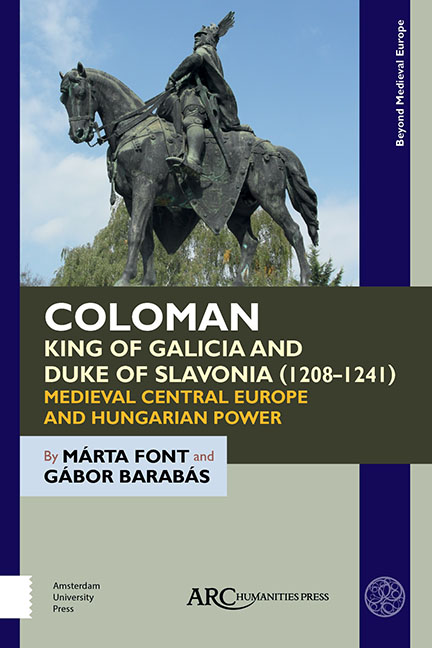 Coloman, King of Galicia and Duke of Slavonia (1208–1241)
Coloman, King of Galicia and Duke of Slavonia (1208–1241) Book contents
- Frontmatter
- Contents
- List of Illustrations
- Foreword
- Introduction
- PART ONE COLOMAN AS CHILD RULER OF GALICIA
- Chapter 1 The Galician Context in 1205
- Chapter 2 The Agreement of Scepus
- Chapter 3 Coloman’s Coronation as King of Galicia: Date and Place
- Chapter 4 The Hungarian Elite and Coloman’s Court
- Chapter 5 Coloman’s Position in Halych, 1215–22: Campaigns and Opponents
- Chapter 6 Upholding the Galician Claim: Coloman’s Place in Hungary
- PART TWO COLOMAN, DUKE OF WHOLE SLAVONIA (1226–1241)
- Chapter 7 Coloman and Scepus, Before 1226
- Chapter 8 Coloman as Duke of Whole Slavonia from 1226
- Chapter 9 Coloman’s Status and the Inner Workings of the Duchy
- Chapter 10 Coloman’s Ecclesiastical and Secular Actitivities in Slavonia
- Chapter 11 Coloman’s Rule in Slavonia
- Chapter 12 Politics and Dynastic Affairs
- Chapter 13 Challenges in the Balkans
- Chapter 14 The Mongol Attack and Coloman’s Death
- Conclusion: Coloman in the Eyes of Posterity
- Bibliography
- Index
Chapter 7 - Coloman and Scepus, Before 1226
Published online by Cambridge University Press: 20 November 2020
- Frontmatter
- Contents
- List of Illustrations
- Foreword
- Introduction
- PART ONE COLOMAN AS CHILD RULER OF GALICIA
- Chapter 1 The Galician Context in 1205
- Chapter 2 The Agreement of Scepus
- Chapter 3 Coloman’s Coronation as King of Galicia: Date and Place
- Chapter 4 The Hungarian Elite and Coloman’s Court
- Chapter 5 Coloman’s Position in Halych, 1215–22: Campaigns and Opponents
- Chapter 6 Upholding the Galician Claim: Coloman’s Place in Hungary
- PART TWO COLOMAN, DUKE OF WHOLE SLAVONIA (1226–1241)
- Chapter 7 Coloman and Scepus, Before 1226
- Chapter 8 Coloman as Duke of Whole Slavonia from 1226
- Chapter 9 Coloman’s Status and the Inner Workings of the Duchy
- Chapter 10 Coloman’s Ecclesiastical and Secular Actitivities in Slavonia
- Chapter 11 Coloman’s Rule in Slavonia
- Chapter 12 Politics and Dynastic Affairs
- Chapter 13 Challenges in the Balkans
- Chapter 14 The Mongol Attack and Coloman’s Death
- Conclusion: Coloman in the Eyes of Posterity
- Bibliography
- Index
Summary
COLOMAN WAS APPROXIMATELY thirteen years old when he and his wife, Salomea, were forced to leave the city of Halych and cease his reign in Galicia. After first returning to Hungary, they then settled in the Scepus region (Szepesség, Spiš), on the estates of the prince. The territory had been given to Coloman probably after the treaty which took place in or around 1214 and it served him—along with Újvár County—as some kind of home base whilst he was in Galicia. Coloman’s presence in the region is verified by a charter of Queen Elizabeth of Hungary from 1279. We should resist ideas of some coherent territory, such as a duchy, since the estates of the prince in Scepus were scattered, even though he owned several castles and their property. This was not territorial power over the whole Scepus region, unlike Coloman’s later situation in Slavonia.
Coloman’s estates might not have been the sole reason why the young royal couple was based in Scepus. Presumably the prince had not completely given up his hopes for Galicia, or maybe his father had not come to a conclusive decision concerning which son would be prominent in Galicia. Still, a letter in 1222 from Pope Honorius III indicates that Andrew II intended to transfer Coloman’s royal title to his younger son, Prince Andrew. However, the pope rejected this on the grounds that a papal enthronement cannot lose its validity, which meant Coloman keeping his royal title until his death. The Hungarian king had to explore another way to support the Galician claims of his youngest son. His hesitation is reflected in his request to the pope to release him from his earlier promise given to Mstislav, which petition also was rejected by Honorius III.
So it is not inconceivable that Coloman could imagine returning to Galicia, justifying staying in Scepus for several years. Other historians argue that the prince was linked to the district through his mother, Gertrude, who along with her brothers, Berthold, Eckbert, and Heinrich, organized the settlement of hospes communities in Scepus. Yet this assumption seems unrealistic, since Scepus was mostly uninhabited at the start of the thirteenth century, and the formation of the royal county was just starting.
- Type
- Chapter
- Information
- Coloman, King of Galicia and Duke of Slavonia (1208–1241)Medieval Central Europe and Hungarian Power, pp. 63 - 68Publisher: Amsterdam University PressPrint publication year: 2019


